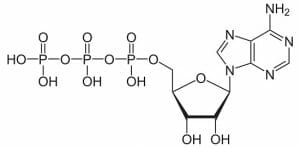Definition of ATP
ATP is a particle that transport energy inside cells. It is the primary energy money of the cell, and it is a finished result of the procedures of photophosphorylation (adding a phosphate gathering to a particle utilizing the energy from light), cell breath, and ageing. In this article, we will teach about the definition of ATP, its structure and formation
Each living thing uses ATP. Moreover, the body cell utilizes it like an energy source. Additionally, they utilize in signal transduction pathways for cell correspondence. It also consolidates into deoxyribonucleic corrosive (DNA) during DNA amalgamation.
Structure of ATP

This is an auxiliary graph of ATP. In addition, it comprises of the particle adenosine (which itself consist of adenine and ribose sugar) and three phosphate gatherings. It is dissolvable in water and has a high energy content due to having two phosphoanhydride bonds associating the three phosphate gatherings.
Elements of ATP
Energy Source
As we describe in the definition of ATP. It is the principal transporter of energy. Also, the cell utilizes it for every single cell movement. At the point when ATP hydrolyze and change over to adenosine diphosphate (ADP), energy discharges.
The expulsion of one phosphate gathering discharges 7.3 kilocalories per mole, or 30.6 kilojoules per mole, under standard conditions. This energy controls all responses that happen inside the cell. ADP can likewise be changed over once more into ATP with the goal that the energy is accessible for other cell responses.
Cell creates ATP through a few different methods. Photophosphorylation is a strategy explicit to plants and cyanobacteria. It is the production of ATP from ADP utilizing the energy from daylight and happens during photosynthesis.
ATP is additionally framed from the procedure of cell breath in the mitochondria of a cell. This can be through high-impact breath, which requires oxygen, or anaerobic breath, which doesn’t.
High-impact breath produces ATP (alongside carbon dioxide and water) from glucose and oxygen. Anaerobic breath utilizes synthetic concoctions other than oxygen, and this procedure is principally utilized by archaea and microbes that live in anaerobic conditions.
Ageing is another method for creating ATP that doesn’t require oxygen; it is unique in relation to anaerobic breath since it doesn’t utilize an electron transport chain. Yeast and microscopic organisms are instances of living beings that utilization maturation to produce ATP.
Signal Transduction
ATP is a flagging particle utilized for cell correspondence. Besides, kinases are compounds that phosphorylate atoms, use ATP as a wellspring of phosphate gatherings. Kinases are significant for signal transduction. It is the manner by which a physical or concoction sign transmits from receptors outside of the cell to the inside of the cell.
When the sign is inside the cell, the cell can react properly. Cells may get the signs to develop, metabolize, divide into different sorts, or even bite the dust.
DNA Synthesis
The nucleobase adenine is a piece of adenosine, a particle that forms from ATP and put straightforwardly into RNA. Moreover, the different nucleobases in RNA, cytosine, guanine, and uracil, are also forms from CTP, GTP, and UTP.
We can locate adenine in DNA. And its consolidation is fundamentally the same as aside from ATP is changed over into the structure deoxyadenosine triphosphate (dATP). It does so before ending up some portion of a DNA strand.
Solved Question for You
Q: How can ATP be produced?
A. Fermentation
B. Cellular respiration
C. Photophosphorylation
D. All of the above
The correct answer is A. Cell produce ATP through fermentation.






Leave a Reply